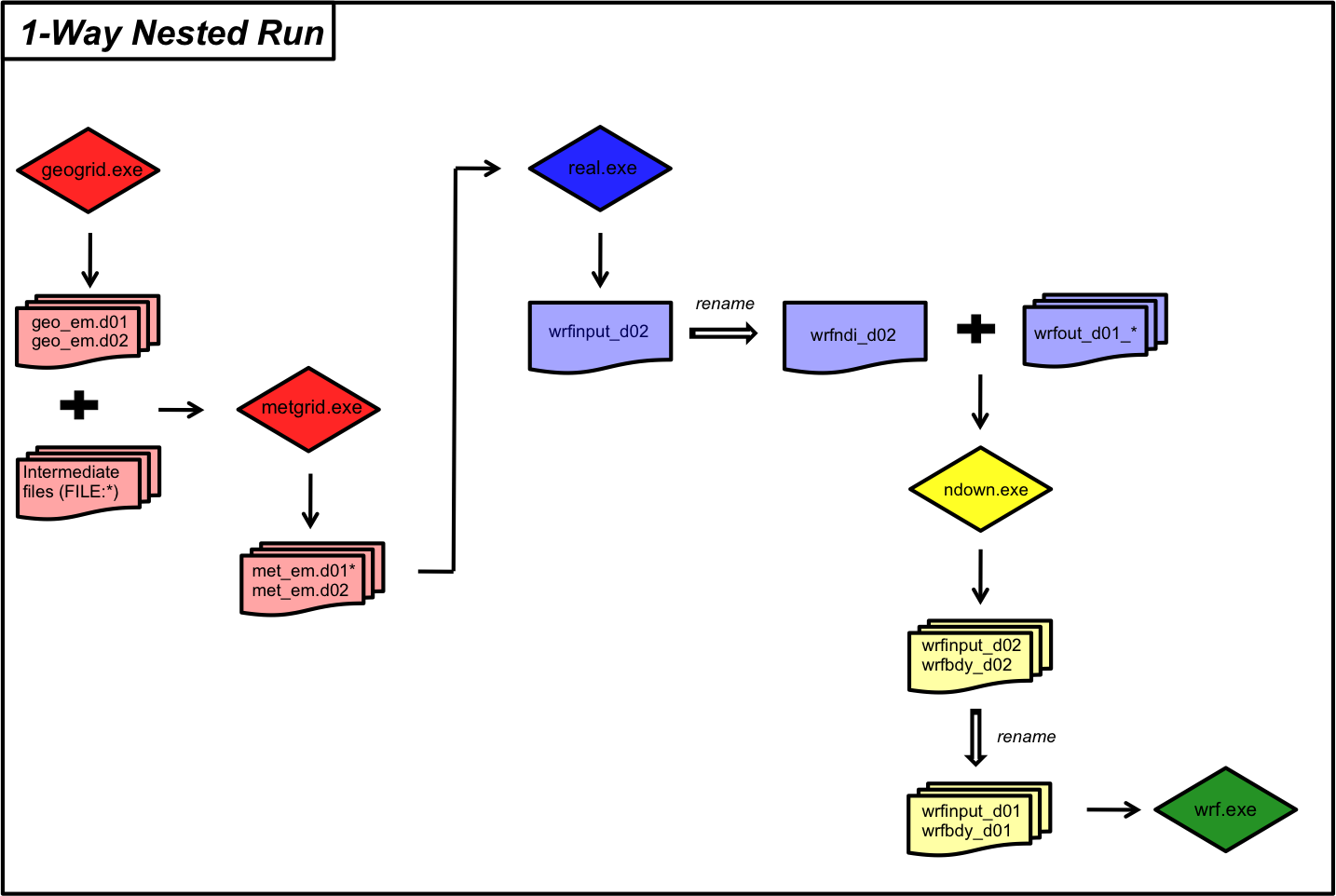The Ndown Program¶
ndown
An option to run a nested domain after running the parent domain, which can be useful for two circumstances:
You ran WRF for a coarse grid(s) over a long period of time (e.g., years), and decide after that you need to run the case again with a finer nested grid, without having to re-run the coarse grid.
You have nested domains that vary greatly in size (e_we and e_sn) from each other. To process small domains, you will not be able to use as many processors as you may need to use for the larger domains. See details.
See the flow-chart for the ndown process:

In this exercise, you will learn how to run ndown. You will use the output files from the Single Domain Run, and add a nest. If you no longer have those output files, return to the Single Domain Run and regenerate them.
Note
When using the ndown option, prepare the runs as if you were doing a normal (basic) nested simulation.
When running WRF for the coarser domain, make sure to write model output in adequate intervals (e.g., 1-3 hourly, especially if the finer domain has resolutions of 1-3 km or less).
Run WPS for Two Domains¶
Note
If you still have met_em* files for both domains 01 and 02 from the Two-way Nested Domain Case, then you can skip this entire section and move straight to Run Real for Two Domains.
Use what you learned from the Two-way Nested Domain Case to modify the namelist appropriately for 2 domains.
Set up a domain over your area of interest
Keep your domain 2 size around 118 x 103 to save on computation and time.
HINT: Use plotgrids_new.ncl to position your domain before you run geogrid.exe.
Once the namelist is set-up, run the three WPS executables (Note: if you still have intermediate files from your original single or nested case, you can skip ungrib. These are not domain-dependent).
Run Real for Two Domains¶
If you saved the output and namelist from the Two-way Nested Domain Case exercise, copy the following files to your wrf/test/em_real directory, and then skip directly to step 5 below:
cp nested/namelist.input . cp nested/wrfbdy_d01 . cp nested/wrfinput_d0* . cp nested/wrfout_d01* .
If you do not already have the files from step 1, edit namelist.input to make sure columns 1 and 2 are set up to run 2 domains. Make sure there are no leftover settings from other practice exercises in there (e.g., any aux* settings, sst_update, restart set to .true., etc.).
Link-in the appropriate WPS files and run real.exe. This will generate the files
wrfinput_d01
wrfinput_d02
wrfbdy_d01The only file needed for the next step (ndown.exe) is wrfinput_d02, which is used with previously-generated wrfout_d01* files. The ndown program is written to recognize a specific naming convention for this file, so rename the file using the following command:
mv wrfinput_d02 wrfndi_d02
Run Ndown¶
ndown.exe uses the following 2 files as input when running. Make sure they are all in the wrf/test/em_real directory:
wrfout_d01_<date> from the single domain case, which serves as the boundary condition file
wrfndi_d02 from the above section, which was previously wrfinput_d02, and serves as the initial condition file
Set-up the namelist.
Edit the namelist so that it now has the following settings - make sure the start and end times for d01 and d02 are set-up for the same period as for your initial run, or you will receive an error!
&time_control io_form_auxinput2 = 2 &domains max_dom = 2,
Note
io_form_auxinput2 = 2 is a mandatory setting for running ndown, and specifies that input stream 2 is in netCDF format
Run ndown.exe, which should output a wrfinput_d02 and a wrfbdy_d02 file.
qsub runndown.sh
Rename output to: wrfinput_d01 and wrfbdy_d01 so that wrf.exe will recognize them as the new “domain 1.”
mv wrfinput_d02 wrfinput_d01 mv wrfbdy_d02 wrfbdy_d01
Run WRF for the Fine-resolution Domain¶
Tip
Copy your namelist.input file to something else (eg. namelist.input.save) in case you want to repeat this process in the future.
Edit namelist.input for the below parameters, copying the following fine-grid domain data from column 2 to column 1 so that this run will be for the fine-grid domain only:
&domains time_step = 60, max_dom = 1, e_we = 118, e_sn = 103, dx = 10000, dy = 10000,
Run wrf.exe, as usual. Output: wrfout_d01_<date>
Note
This is d02 output, even though the file name says d01.
Return to the Practice Exercise home to page to run another exercise.
